I'll never forget my first taste of authentic La Paz Batchoy during a business trip to Iloilo City. After a long day of meetings, a local colleague insisted we skip the hotel food and head to a small, bustling eatery in the La Paz district.
That steaming bowl of noodle soup changed everything I thought I knew about batchoy - the rich bone marrow broth that had been simmering for hours, the perfectly chewy miki noodles, tender pieces of pork, and that magical moment when the raw egg yolk melted into the hot soup.
I spent weeks perfecting this la paz batchoy recipe, calling my Ilonggo friends for their family secrets, and now I'm thrilled to share my version of this Ilonggo classic that's as close as you can get to the streets of La Paz.
While it takes a few hours to make, most of it is hands-off simmering time - perfect for lazy Sunday cooking when you want to fill your home with the mouthwatering aroma of garlicky bone broth. Once you try this homemade La Paz Batchoy, there's no going back to instant versions.
Jump to:
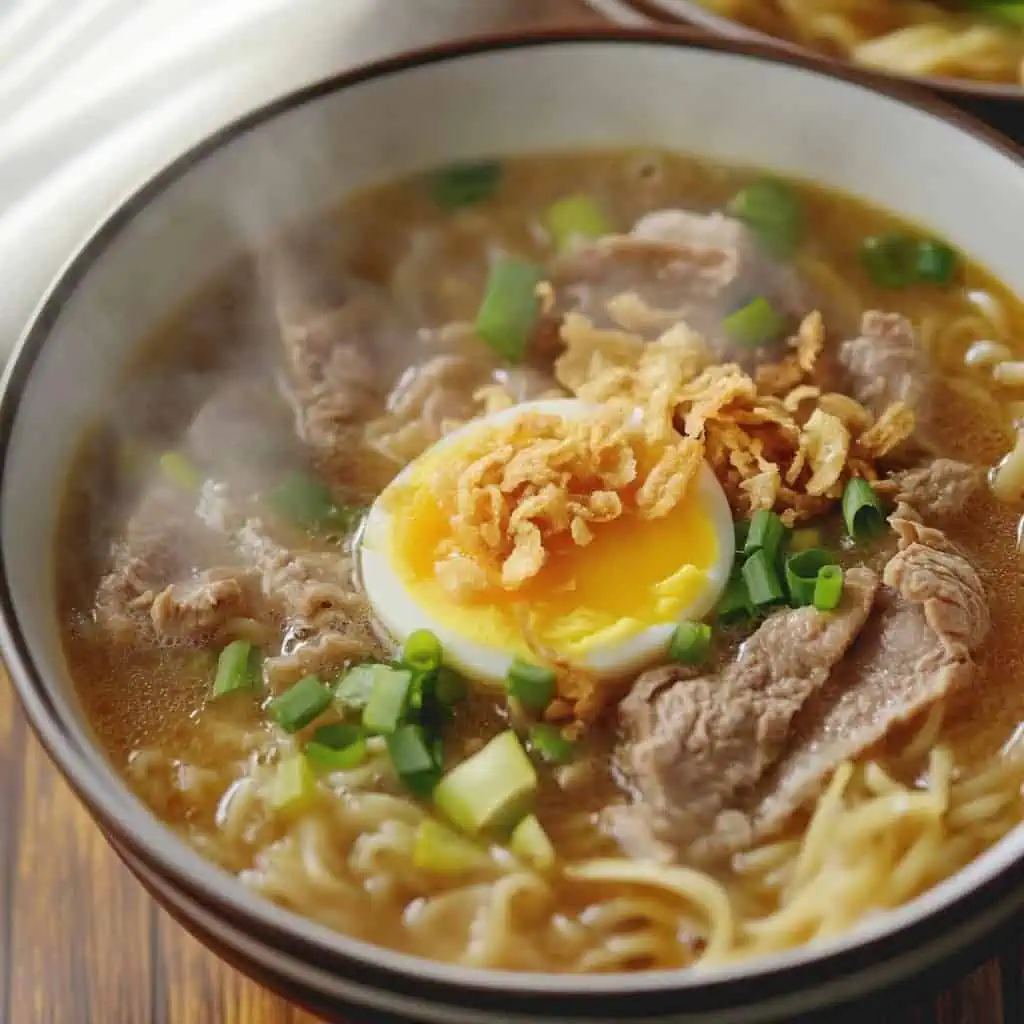
Why You'll Love This Recipe
- Authentic taste straight from Iloilo's kitchens
- Rich, complex bone broth developed over hours of slow cooking
- Perfect balance of textures from silky noodles to crunchy chicharon
- Deeply satisfying and comforting, especially during cold weather
- Complete meal in one bowl
- Customizable toppings to suit your taste
- Freezer-friendly broth for future meals
Ingredients
Each component of La Paz Batchoy serves a specific purpose: the pork and beef bones create a rich, collagen-packed broth; shrimp paste adds umami depth; miki noodles provide the authentic chewy texture; the variety of meats (shoulder, intestines, and liver) offers contrasting flavors and textures; while the toppings (chicharon, fried garlic, green onions, and raw egg) add layers of crunch, aroma, freshness and creaminess that make this soup truly exceptional.
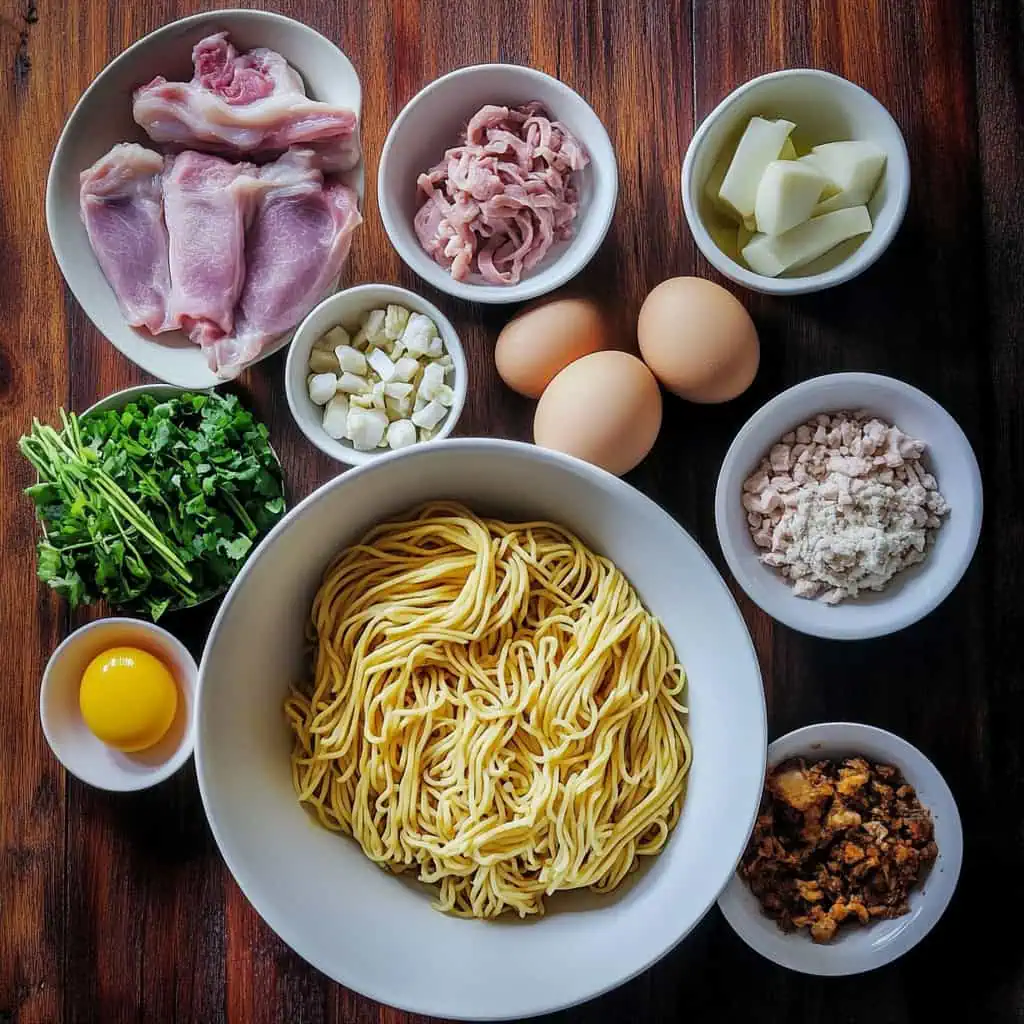
For the Broth (Sabaw)
- 3 pounds pork bones
- 2 pounds beef bones with marrow
- 1 whole red onion, minced
- 2 whole garlic heads, minced
- 1 tablespoon sautéed shrimp paste
- 2 tablespoons sugar
- Rock salt and pepper to taste
- 14-16 cups water
Main Components
- 2 packages (16 ounces each) fresh miki noodles
- ½ pound pork shoulder
- ½ pound cleaned pork intestines
- ½ pound pork liver
Toppings (Sahog)
- Crushed pork cracklings (chicharon)
- Fried garlic bits
- Green onions, chopped
- 8 whole raw eggs
Equipment
- Large stock pot - For making the rich bone broth that forms the foundation of authentic batchoy
- Fine-mesh strainer - Essential for achieving a clear, clean broth by removing impurities
- Sharp knife - For precise cutting of meats to ensure even cooking and proper texture
- Cutting board - Provides a stable surface for all your preparation work
- Kitchen scale - Helps with accurate measurements for consistent results
- Soup Bowls - Traditional deep bowls are best for serving batchoy properly
- Spider Strainer - Perfect for blanching and retrieving noodles without breaking them
- Ladle - For serving the hot broth without splashing
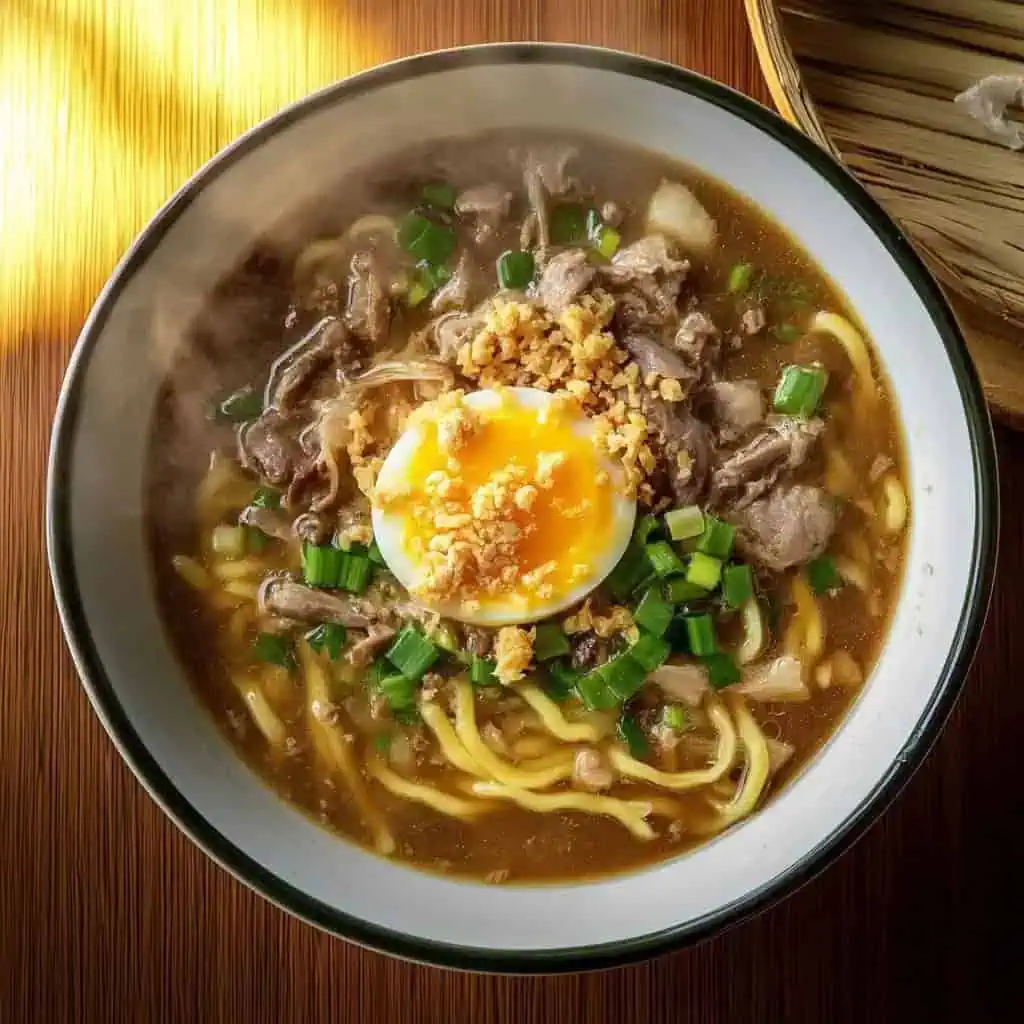
How To Make
- Fill a large pot with water and bring it to a boil. Add your pork and beef bones, then boil them for 10 minutes. While boiling, remove any grayish foam that floats to the top. Drain the bones and rinse them well under running water. Clean your pot before continuing.
- Put the cleaned bones back in the pot and add fresh cold water until the bones are covered. Bring to a boil again, then lower the heat so the liquid just gently bubbles. Cover and let it cook slowly for 2 hours. Occasionally skim off any foam that forms on top.
- Pour the broth through a strainer. Pick off any meat stuck to the bones and save it. Using a small spoon, scoop out the white marrow from inside the beef bones and set aside. You can throw away the cleaned bones now.
- Pour the strained broth back into the pot and bring it to a boil. Add the pork shoulder and intestines. Cook for about 30-40 minutes until they're tender. Take them out, let them cool a bit, then slice them into thin strips.
- Add the liver to the broth and cook for 7-10 minutes. Take it out, let it cool slightly, then slice it thinly.
- Add your chopped onions and garlic to the hot broth. Cook for 2-3 minutes until soft. Stir in the sautéed shrimp paste until it's mixed well into the broth. Add sugar, then season with salt and pepper until it tastes good to you.
- In a separate pot, boil water for the noodles. Cook the fresh miki noodles for just 30-40 seconds. Drain them well and divide them between your serving bowls.
- Pour the hot broth over the noodles. Add the sliced pork, intestines, liver, and saved meat from the bones. Put some bone marrow in each bowl if you like.
- Top each bowl with crushed chicharon, fried garlic bits, and chopped green onions. If you want, crack a raw egg into each bowl. Serve right away while it's very hot.
- Always serve extra hot broth on the side for refills, and keep your toppings nearby so everyone can add more as they eat. Remember, La Paz Batchoy is best enjoyed steaming hot - this helps all the flavors come together and lets the egg gently cook in the hot broth.

Tips from Lola's Kitchen
For clear broth:
- Always blanch bones first to remove impurities
- Maintain a gentle simmer, never a rolling boil
- Skim regularly throughout the cooking process
- Use a fine-mesh strainer lined with cheesecloth for ultra-clear results
- Add cold water to bones, not hot, for clearer broth
For best flavor:
- Toast garlic until golden brown but not burnt
- Use fresh, not frozen, miki noodles for authentic texture
- Don't overcook the liver to prevent bitterness
- Add shrimp paste gradually and taste as you go
- Let the broth rest for 30 minutes before serving to allow flavors to meld
- Crush chicharon just before serving to maintain crunchiness
- Use bone marrow from beef bones for extra richness
Substitutions
- Fresh miki noodles: Dried egg noodles can work, but adjust cooking time according to package instructions
- Pork intestines: Double the pork shoulder if intestines aren't available or to your liking
- Raw egg: Substitute with a poached egg if you prefer
- Sautéed shrimp paste: Fish sauce (patis) can be used instead, though the flavor profile will be different
- Bone marrow: Add extra meat if you prefer to skip this
- Pork shoulder: Pork belly can be used for a richer version
- Green onions: Regular chives work in a pinch
- Fried garlic: Garlic powder as a last resort, but fresh is significantly better
Troubleshooting
Cloudy Broth
- Problem: Broth looks murky or cloudy
- Solution: Ensure bones are properly blanched first, maintain a gentle simmer rather than a boil, and be diligent about skimming impurities
Tough Meat
- Problem: Pork pieces are chewy or rubbery
- Solution: Extend cooking time by 15-20 minutes while maintaining a lower temperature; slice against the grain when cutting
Mushy Noodles
- Problem: Noodles lose their texture
- Solution: Cook miki noodles very briefly, just 30-40 seconds, and serve immediately; if preparing ahead, keep noodles separate until serving
Bland Taste
- Problem: Broth lacks depth or flavor
- Solution: Add more sautéed shrimp paste gradually, adjust salt levels, enhance with additional fried garlic, or try adding a splash of fish sauce
Greasy Broth
- Problem: Too much oil floating on top
- Solution: Refrigerate broth overnight and remove solidified fat before reheating; alternatively, skim with a ladle or use a fat separator
Storage & Reheating
Storage:
- Broth: Keeps 3-4 days in the refrigerator or up to 3 months in the freezer
- Cooked meats: Store separately for 2-3 days in the refrigerator
- Assembled bowl: Best consumed immediately, not suitable for storage
- Toppings: Store dry toppings (chicharon, fried garlic) in airtight containers at room temperature
Reheating:
- Broth: Always bring to a full boil before serving
- Noodles: Always prepare fresh for best texture
- Meats: Add to hot broth just until warmed through to prevent overcooking
- Complete dish: Never reheat a fully assembled bowl - instead, reheat components separately
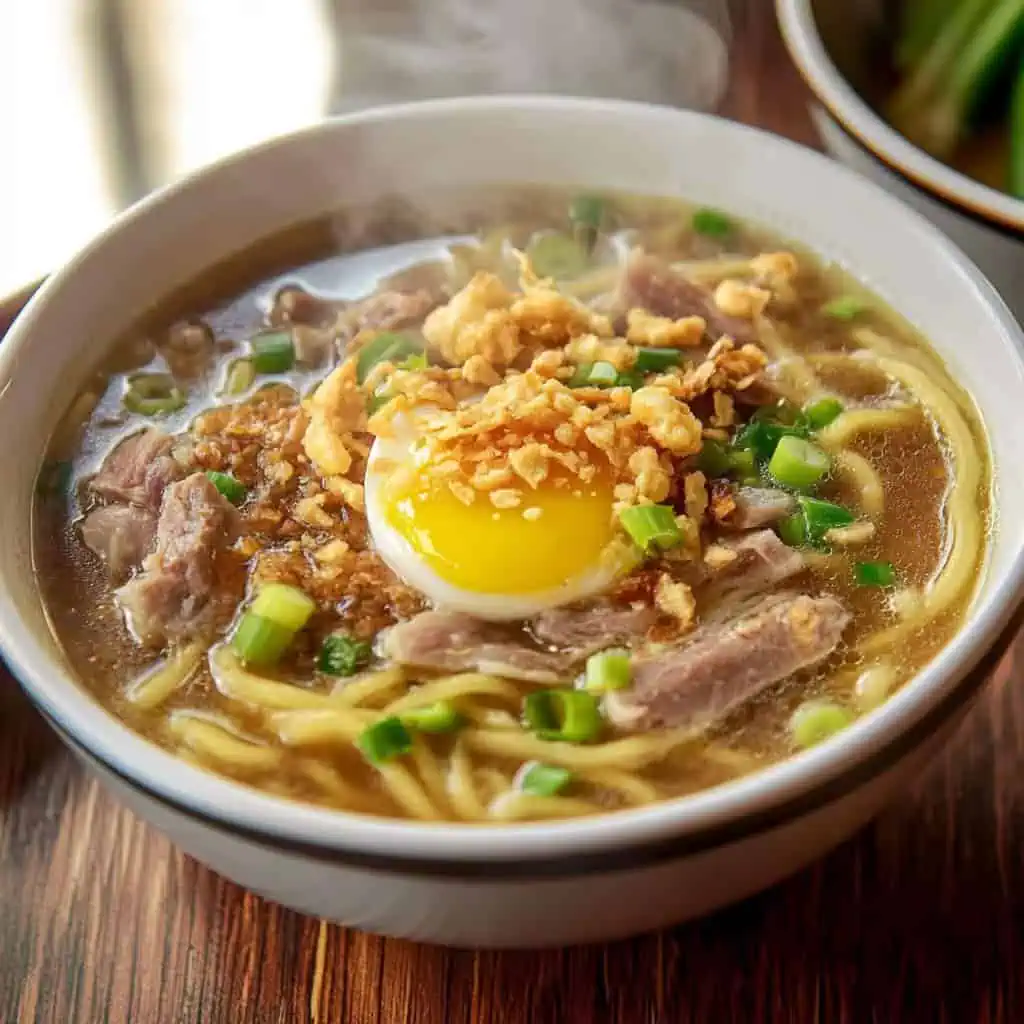
FAQ
Can I make the broth ahead of time?
Yes, the broth actually improves with time! It keeps well in the refrigerator for 3-4 days or frozen for up to 3 months. This makes it perfect for meal prep.
Is the raw egg safe to eat?
The raw egg is traditional, but if you're concerned about safety, use pasteurized eggs or simply omit this ingredient. Alternatively, you can poach the egg separately.
How do I clean pork intestines properly?
Soak them in vinegar water (1 cup vinegar to 4 cups water) for 30 minutes, then rinse thoroughly under cold running water. Boil with ginger first to remove any unwanted smell before adding to your main broth.
Can I use instant noodles instead of fresh miki?
Fresh miki is traditional and gives the authentic texture. While you can use instant noodles in a pinch, the results won't be the same. If using instant noodles, discard the flavor packet and just use the noodles.
Why is my broth not as flavorful as restaurant versions?
Restaurant batchoy typically simmers for 4-6 hours or even overnight. For deeper flavor, extend your simmering time and make sure you're using enough bones with marrow.
Can I make a vegetarian version?
Traditional La Paz Batchoy relies heavily on meat products for its authentic flavor. While you could make a mushroom-based broth with vegetarian toppings, it would be a different dish entirely.
How can I make a quicker version if I'm short on time?
Use a pressure cooker for the bones (45 minutes instead of 2 hours), pre-made bone broth as a base, or high-quality store-bought bone broth enhanced with sautéed aromatics and shrimp paste.
What should I serve with La Paz Batchoy?
Traditional accompaniments include puto (Filipino rice cakes), fresh pandesal (Filipino bread rolls), calamansi halves for squeezing, additional chicharon on the side, and extra fried garlic for topping.
Related
Looking for other recipes like this? Try these:
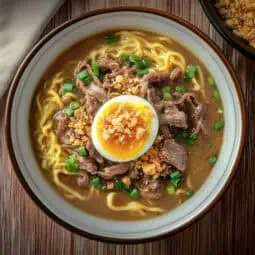
La Paz Batchoy
Equipment
- Large stock pot (kaldero) For making the rich bone broth
- Fine-mesh strainer (salaan) For achieving clear broth
- Sharp knife (kutsilyo) For precise meat cutting
- Cutting board (Sangkalan) For preparation work
- Kitchen scale (timbangan) For accurate measurements
- Soup Bowls (Mangkok) Traditional deep bowls for serving
- Spider Strainer (Sandok Butas) For blanching noodles
- Ladle - sandok For serving hot broth
Ingredients
For the Broth (Sabaw)
- 3 pounds pork bones buto ng baboy
- 2 pounds beef bones with marrow buto ng baka na may utak
- 1 whole red onion minced (sibuyas)
- 2 whole garlic heads minced (bawang)
- 1 tablespoon sautéed shrimp paste ginisang bagoong alamang
- 2 tablespoons sugar asukal
- Rock salt asin and pepper (paminta) to taste
- 14-16 cups water tubig
Main Components
- 2 packages 16 ounces each fresh miki noodles (sariwang miki)
- ½ pound pork shoulder kasim
- ½ pound cleaned pork intestines bituka ng baboy
- ½ pound pork liver atay ng baboy
Toppings (Sahog)
- Crushed pork cracklings dinurog na chicharon
- Fried garlic bits sinangag na bawang
- Green onions chopped (sibuyas dahon)
- 8 whole raw eggs hilaw na itlog
Instructions
- Fill a large pot with water and bring it to a boil. Add your pork and beef bones, then boil them for 10 minutes. While boiling, remove any grayish foam that floats to the top. Drain the bones and rinse them well under running water. Clean your pot before continuing.
- Put the cleaned bones back in the pot and add fresh cold water until the bones are covered. Bring to a boil again, then lower the heat so the liquid just gently bubbles. Cover and let it cook slowly for 2 hours. Occasionally skim off any foam that forms on top.
- Pour the broth through a strainer. Pick off any meat stuck to the bones and save it. Using a small spoon, scoop out the white marrow from inside the beef bones and set aside. You can throw away the cleaned bones now.
- Pour the strained broth back into the pot and bring it to a boil. Add the pork shoulder and intestines. Cook for about 30-40 minutes until they're tender. Take them out, let them cool a bit, then slice them into thin strips.
- Add the liver to the broth and cook for 7-10 minutes. Take it out, let it cool slightly, then slice it thinly.
- Add your chopped onions and garlic to the hot broth. Cook for 2-3 minutes until soft. Stir in the sautéed shrimp paste until it's mixed well into the broth. Add sugar, then season with salt and pepper until it tastes good to you.
- In a separate pot, boil water for the noodles. Cook the fresh miki noodles for just 30-40 seconds. Drain them well and divide them between your serving bowls.
- Pour the hot broth over the noodles. Add the sliced pork, intestines, liver, and saved meat from the bones. Put some bone marrow in each bowl if you like.
- Top each bowl with crushed chicharon, fried garlic bits, and chopped green onions. If you want, crack a raw egg into each bowl. Serve right away while it's very hot.
- Always serve extra hot broth on the side for refills, and keep your toppings nearby so everyone can add more as they eat. Remember, La Paz Batchoy is best enjoyed steaming hot - this helps all the flavors come together and lets the egg gently cook in the hot broth.
Tips from Lola's Kitchen
- Para sa malinaw na sabaw (For clear broth):
- Always blanch bones first
- Simmer, never boil
- Skim regularly
- Strain through fine mesh
- Para sa masarap na lasa (For best flavor):
- Toast garlic until golden brown
- Use fresh, not frozen, miki noodles
- Don't overcook the liver
- Add shrimp paste gradually to taste
Nutrition
The Story Behind La Paz Batchoy
In the bustling streets of La Paz, Iloilo City, a culinary legacy was born in the 1930s that would forever change Filipino soup culture. La Paz Batchoy, the iconic noodle soup that captures both hearts and palates, traces its roots to the Chinese community that once thrived in the historic La Paz district. The dish's name itself reveals its fascinating origins - "Batchoy" evolved from "Ba-Chui," a Hokkien Chinese term meaning "pieces of meat," reflecting the soup's hearty, meat-rich character that defines it today.
Federico Guillergan Sr., often credited as the father of modern La Paz Batchoy, transformed this humble Chinese-inspired soup into what Filipinos know and love today. Working as a butcher in the La Paz public market, Guillergan experimented with combining Chinese noodle soup traditions with local Filipino ingredients and flavors. His innovation? The addition of guinamos (shrimp paste) to the bone broth, creating that distinctive umami depth that sets La Paz Batchoy apart from other Filipino noodle soups.
What began as simple market fare has evolved into a cultural phenomenon. The original recipe featured only pork organs and broth, but over time, the soup acquired its signature elements: miki noodles, bone marrow-enriched broth, tender meats, crushed chicharon, and that crowning glory - the raw egg that creates a luxurious finish when stirred into the steaming soup. Today, countless batchoy houses line the streets of La Paz, each claiming to serve the most authentic version, but all paying homage to this remarkable fusion of Chinese and Ilonggo culinary traditions.
While modern interpretations abound, traditional La Paz Batchoy remains a testament to Filipino ingenuity in transforming foreign influences into something uniquely our own. From its humble beginnings as a market worker's meal to its current status as a celebrated Filipino comfort food, La Paz Batchoy embodies the rich tapestry of Philippine cuisine - where every bowl tells a story of cultural exchange, innovation, and the timeless appeal of a well-made soup.
The dish's evolution continues as new generations discover and reinvent it, but the soul of La Paz Batchoy remains unchanged: a hearty, satisfying bowl of noodle soup that carries within it the flavors of history, the warmth of community, and the pride of Iloilo. Whether enjoyed in a humble carinderia or an upscale restaurant, each bowl of La Paz Batchoy serves as a delicious reminder of how cultural connections and local creativity can create something truly extraordinary.
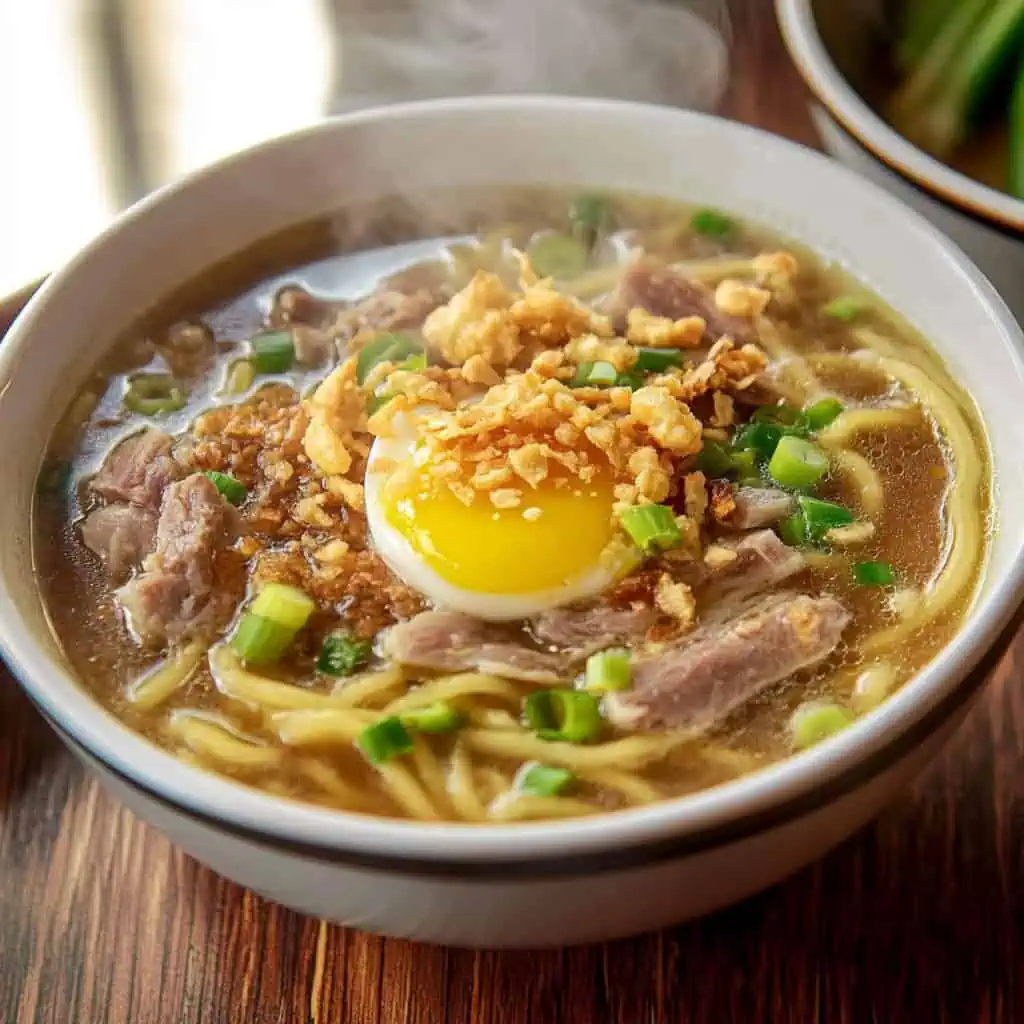









Comments
No Comments